教案healthproblem
- 格式:doc
- 大小:37.00 KB
- 文档页数:2
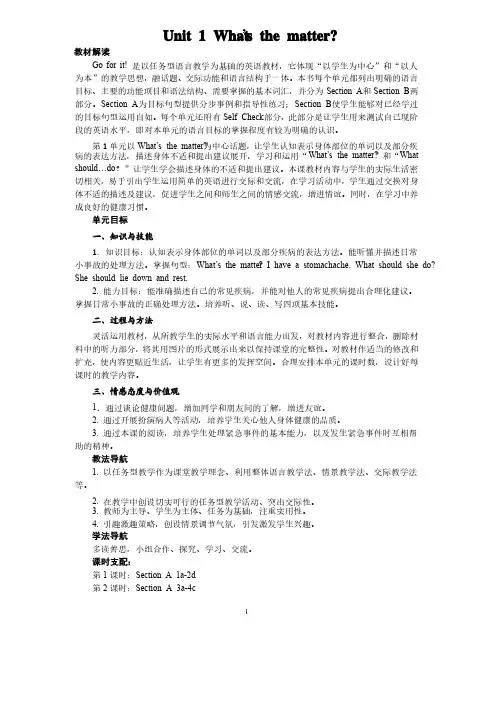
1 Unit 1 What’s the matter? 教材解读Go Go for for for it! it! 是以任务型语言教学为基础的英语教材,它体现“以学生为中心”和“以人为本”的教学思想,融话题、交际功能和语言结构于一体。
交际功能和语言结构于一体。
本书每个单元都列出明确的语言本书每个单元都列出明确的语言目标、主要的功能项目和语法结构、需要掌握的基本词汇,并分为Section A 和Section B 两部分。
Section A 为目标句型提供分步事例和指导性练习;Section B 使学生能够对已经学过的目标句型运用自如。
每个单元还附有Self Check 部分,此部分是让学生用来测试自己现阶段的英语水平,即对本单元的语言目标的掌握程度有较为明确的认识。
第1单元以What’s What’s the matter? the matter?为中心话题,为中心话题,让学生认知表示身体部位的单词以及部分疾病的表达方法,描述身体不适和提出建议展开,学习和运用“What’s What’s the matter? the matter?”和“”和“What should…do ”让学生学会描述身体的不适和提出建议。
?”让学生学会描述身体的不适和提出建议。
本课教材内容与学生的实际生活密本课教材内容与学生的实际生活密切相关,易于引出学生运用简单的英语进行交际和交流,易于引出学生运用简单的英语进行交际和交流,在学习活动中,在学习活动中,学生通过交换对身体不适的描述及建议,促进学生之间和师生之间的情感交流,体不适的描述及建议,促进学生之间和师生之间的情感交流,增进情谊。
同时,在学习中养增进情谊。
同时,在学习中养成良好的健康习惯。
单元目标一、知识与技能1. 1. 知识目标:认知表示身体部位的单词以及部分疾病的表达方法。
能听懂并描述日常知识目标:认知表示身体部位的单词以及部分疾病的表达方法。
能听懂并描述日常小事故的处理方法。
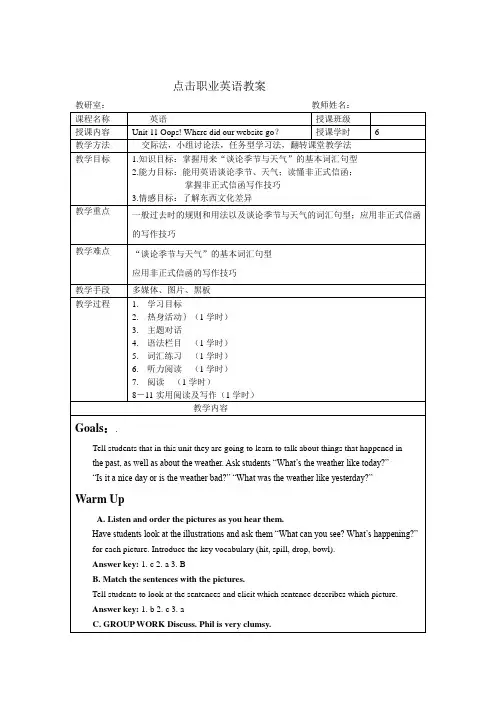
点击职业英语教案教研室:教师姓名:Are you sometimes clumsy? Do you have a clumsy friend?Present the word clumsy by miming dropping something and by having students look at the definition on the post-it.clumsy = not careful; often breaks thingsConversationAll that work!A.Look at the story and listen.Have students look at the photos and ask “Who can you see?” “Where are they?” “What are they doing?”Responses:Mike and Phil.They are in Mike’s new office.They are looking at Mike’s websites.Tell students they are going to read and listen to the conversation to find out what happened to Mike’s website.B. What are Phil and Mike looking at? What did Phil do? Is Mike’s website okay?Ask students the questions.Answer key: Mike’s new website.He pulled out a wire.Yes, because he saved it before Phil arrived.GrammarTalking about the pastCase y: Was Phil at Mike’s office?Annie: Yes, he was.Casey: Were you there, too?Annie: No, I wasn’t. I was at karate class.一般过去时构成be→was—( am,is 的过去式)were—( are 的过去式)V.→V-ed ( 动词过去式)用法表示过去发生的动作或状态,通常会有明确的表示过去的时间状语.I went to the zoo yesterday.I stayed up last night.一、动词的变化1.直接加ed:work—worked look—looked2.以不发音e结尾的单词,直接加d:live—lived hope—hoped use—used3.以辅音字母+y结尾的,变y为i加ed:study—studied carry—carried4.以重读闭音节结尾的,双写最后的辅音字母+ed:stop—stopped plan—planned 6.不规则变化的动词过去式:have—had are—were get—got say—said feel—felt do/does—did is—was go—went drink—drank eat—ate bring—brought think—thought buy—bought catch—caught teach—taught sit—sat wear—wore cut—cut sweep—swept sleep—slept become—becamePronunciationPast tense endings of regular verbs can be pronounced /t/, /d/, or /Id/. Listen to these past tense verbs.Vocabulary in ContextTalking about the seasons and weatherWrite the months of the year on the board from January through December and ask students which month it is at the moment. Have them listen and repeat the months of the year. Pointout that we always write the months with a capital letter. Reinforce understanding by asking students at random which month their birthday is in.Have students look at the photos and present the season and the weather for each. Explainthat fall is more common in the United States and autumn is used more in Great Britain.A. PAIR WORK What was the weather like last year? Take turns. Ask and answer questions about the weather.B. PAIR WORK Student A: look at the website map below. Student B: turn to page 176. Have students look at the weather map for March 5th. Establish that you are looking at a datein the past. Focus stu dents’ attention on the temperatures and review the numbers markedin Fahrenheit and Centigrade. Choose a couple of cities on the map and ask students“What was the weather like in...?”Elicit sentences such as, “It was warm.” “It was cold.” “It was 72 degrees Fahrenheit.” “It was 8 degrees Celsius.” and so on.Listening in ContextA.Listen. Write the names of the seasons.Tell students they are going to listen to four conversations and should pay attention to the season that is referred to in each conversation.D. Answer T (true) or F (false) to the following questions about the letter.1. Mary’s new address is 92 Tower Bridge Apartments.2. John and Mary painted the living room and bathroom.3. The living room is small.4. Mary has put up some pictures.5. Jane has invited Mary to visit for a weekend.6. Jane wants Mary’s Noodle recipe.。
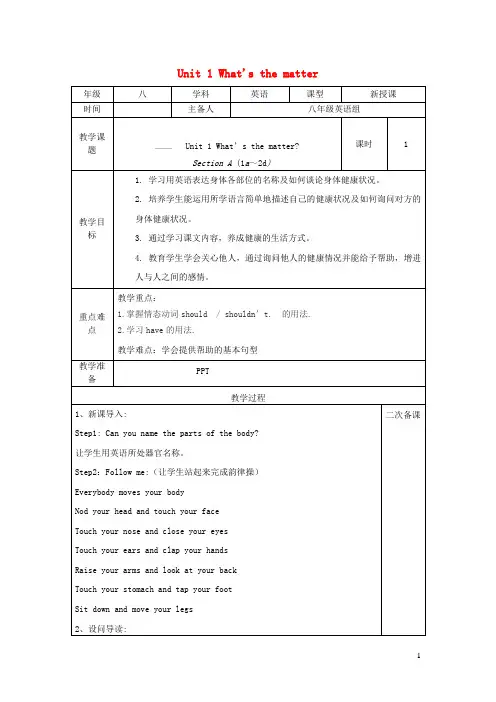
Unit 1 What's the matter年级八学科英语课型新授课时间主备人八年级英语组教学课题Unit 1 What’s the matter?Section A (1a~2d)课时 1教学目标1. 学习用英语表达身体各部位的名称及如何谈论身体健康状况。
2. 培养学生能运用所学语言简单地描述自己的健康状况及如何询问对方的身体健康状况。
3. 通过学习课文内容,养成健康的生活方式。
4. 教育学生学会关心他人,通过询问他人的健康情况并能给予帮助,增进人与人之间的感情。
重点难点教学重点:1.掌握情态动词should / shouldn’t.的用法.2.学习have的用法.教学难点:学会提供帮助的基本句型教学准备PPT教学过程1、新课导入:Step1: Can you name the parts of the body?让学生用英语所处器官名称。
Step2:Follow me:(让学生站起来完成韵律操)Everybody moves your bodyNod your head and touch your faceTouch your nose and close your eyesTouch your ears and clap your handsRaise your arms and look at your backTouch your stomach and tap your footSit down and move your legs2、设问导读:二次备课4. 如果你的头和脖子明天仍然疼的话,请去看医生。
五.拓展探究Homework: Make up a conversation between a doctor and a patient.课堂小结本课通过身体器官韵律操导入课时内容,激发学生的学习兴趣,提高课堂教学的效率,同时针对学生日常生活中的常见症状,让学生在列举过程中掌握患病方式的三种表达方式。
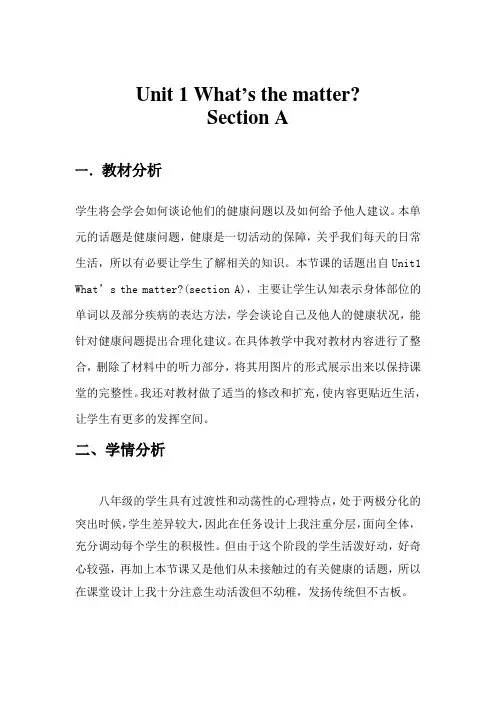
Unit 1 What’s the matter?Section A一.教材分析学生将会学会如何谈论他们的健康问题以及如何给予他人建议。
本单元的话题是健康问题,健康是一切活动的保障,关乎我们每天的日常生活,所以有必要让学生了解相关的知识。
本节课的话题出自Unit1 What’s the matter?(section A),主要让学生认知表示身体部位的单词以及部分疾病的表达方法,学会谈论自己及他人的健康状况,能针对健康问题提出合理化建议。
在具体教学中我对教材内容进行了整合,删除了材料中的听力部分,将其用图片的形式展示出来以保持课堂的完整性。
我还对教材做了适当的修改和扩充,使内容更贴近生活,让学生有更多的发挥空间。
二、学情分析八年级的学生具有过渡性和动荡性的心理特点,处于两极分化的突出时候,学生差异较大,因此在任务设计上我注重分层,面向全体,充分调动每个学生的积极性。
但由于这个阶段的学生活泼好动,好奇心较强,再加上本节课又是他们从未接触过的有关健康的话题,所以在课堂设计上我十分注意生动活泼但不幼稚,发扬传统但不古板。
三.教学目标1、Knowledge Objectives(知识目标)(1)掌握身体每个部分生词的发音,含义以及描述健康问题的词汇,Be able to master the pronunciation,meaning and spelling of the names of body parts and diseases.(2)如何根据别人的健康问题提建议。
Be able to learn the expressions of giving advice.(3)能够运用“What’s the matter? I have a……”谈论健康问题,能运用“You should ……You shouldn’t……”句型给出建议。
Be able to talk about health problems b y using “What’s the matter? I have a……” and give advice by using “You should ……You shouldn’t……”2.Ability Objectives(技能目标):(1)能听懂谈论健康问题的对话材料;Be able to understand the dialogue materials about health problems (2)能够流利的讨论据别人的健康问题提建议;Be able to talk about one’s health problems and give advice fluently (3)能写出重点单词和重点句型,并能描述怎样对待健康问题Be able to write key words and sentence patterns, and describe how to deal with health problems.3.Moral Objectives(情感态度目标)(1)通过本课的阅读,通过开展扮演病人等活动,培养学生关心他人身体健康的品质。
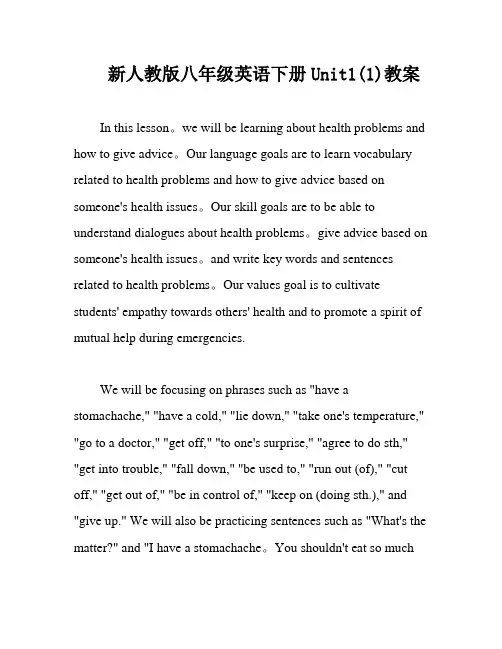
新人教版八年级英语下册Unit1(1)教案In this lesson。
we will be learning about health problems and how to give advice。
Our language goals are to learn vocabulary related to health problems and how to give advice based on someone's health issues。
Our skill goals are to be able to understand dialogues about health problems。
give advice based on someone's health issues。
and write key words and sentences related to health problems。
Our values goal is to cultivate students' empathy towards others' health and to promote a spirit of mutual help during emergencies.We will be focusing on phrases such as "have a stomachache," "have a cold," "lie down," "take one's temperature," "go to a doctor," "get off," "to one's surprise," "agree to do sth," "get into trouble," "fall down," "be used to," "run out (of)," "cut off," "get out of," "be in control of," "keep on (doing sth.)," and "give up." We will also be practicing sentences such as "What's the matter?" and "I have a stomachache。
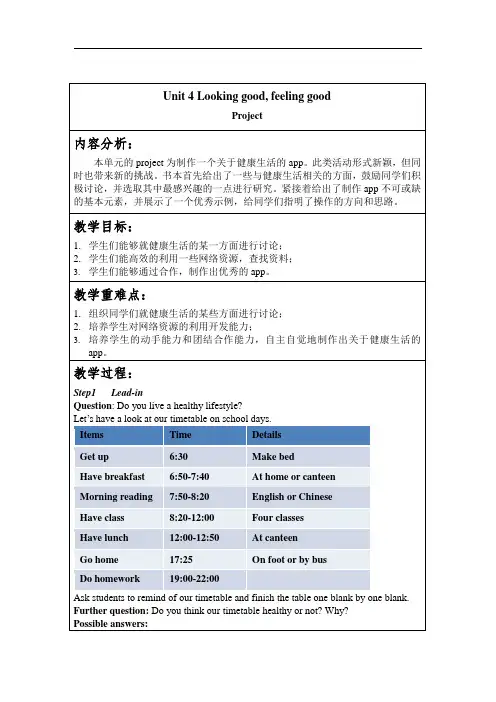
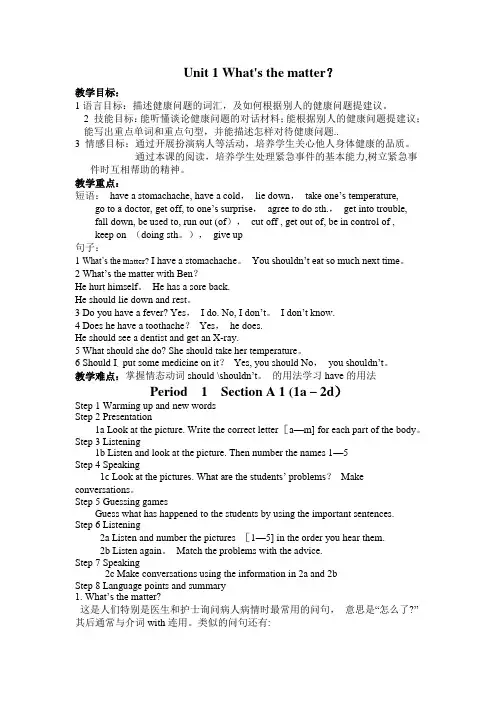
Unit 1 What's the matter?教学目标:1语言目标:描述健康问题的词汇,及如何根据别人的健康问题提建议。
2 技能目标:能听懂谈论健康问题的对话材料;能根据别人的健康问题提建议;能写出重点单词和重点句型,并能描述怎样对待健康问题..3 情感目标:通过开展扮演病人等活动,培养学生关心他人身体健康的品质。
通过本课的阅读,培养学生处理紧急事件的基本能力,树立紧急事件时互相帮助的精神。
教学重点:短语:have a stomachache, have a cold,lie down,take one’s temperature, go to a doctor, get off, to one’s surprise,agree to do sth.,get into trouble,fall down, be used to, run out (of),cut off , get out of, be in control of ,keep on (doing sth。
),give up句子:1 What’s the m atter? I have a stomachache。
You shouldn’t eat so much next time。
2 What’s the matter with Ben?He hurt himself。
He has a sore back.He should lie down and rest。
3 Do you have a fever? Yes,I do. No, I don’t。
I don’t know.4 Does he have a toothache?Yes,he does.He should see a dentist and get an X-ray.5 What should she do? She should take her temperature。
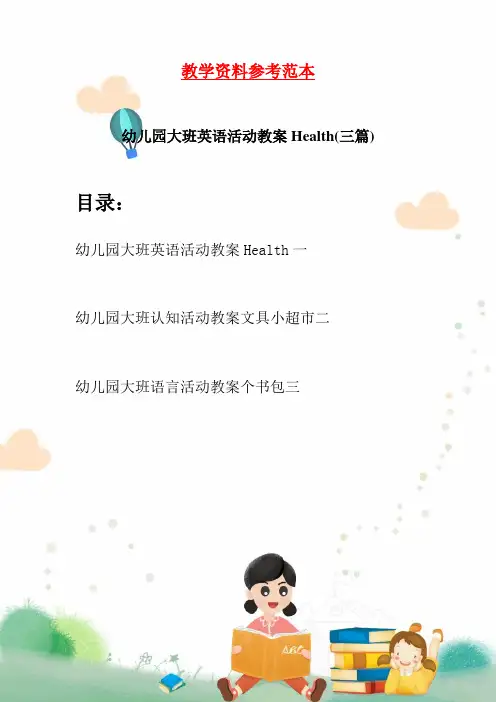
教学资料参考范本幼儿园大班英语活动教案Health(三篇)目录:幼儿园大班英语活动教案Health一幼儿园大班认知活动教案文具小超市二幼儿园大班语言活动教案个书包三幼儿园大班英语活动教案Health一一,、活动名称:大班英语:《health》二:活动目标:1、能够认识健康的英语单词会读会说,知道一些健康的生活方式与习惯;2、培养对英语的兴趣,主动并乐意参与英语活动中,学会模仿教师读英语,知道一些简单的关于养成健康生活习惯的英语表达;复习原来学过的"运动" ﹑"唱" ﹑"跳" ﹑"笑"的英语。
3、了解健康身体的重要性,并好好保护自己的身体。
三、活动准备:《健康歌》的视频,一些英语卡片与图四、活动过程:1、老师作t:"hello evelyone,i'm jojo,i'm very glad to be you english teacher ,now the class is begin ,are you ready?"t:大家好!我是你们的英语老师jojo,很高兴能为大家上英语课。
现在,你们准备好上课了吗?s:准备好了。
t:准备好了就跟老师一起说:yes!s:yes.t:yes,you are so good.开始呢!老师要告诉大家三个手势,当我把手抬高大家就大声的说:yes,手放平的时候大家的声音像这样说:yes当jojo把手放在下面时大家就小声的说:yes。
"are you ready?"s:yes.t:所有的小朋友眼睛看前面的视频,跟着视频和老师一起动起来,看哪个小朋友最有活力。
s;好。
t: (音乐声结束)刚才小朋友表现得都非常的有活力,你们知道刚才那首歌叫什么名字吗?你们喜欢听刚才那首歌吗?s:健康歌,喜欢。
t:嗯,很正确。
我们刚才听的健康歌英文名叫《healthy song》,马上圣诞节就快到了,圣诞老人特别喜欢能跟他说英语的小朋友,他说;谁跟他说英语,他就送谁礼物。
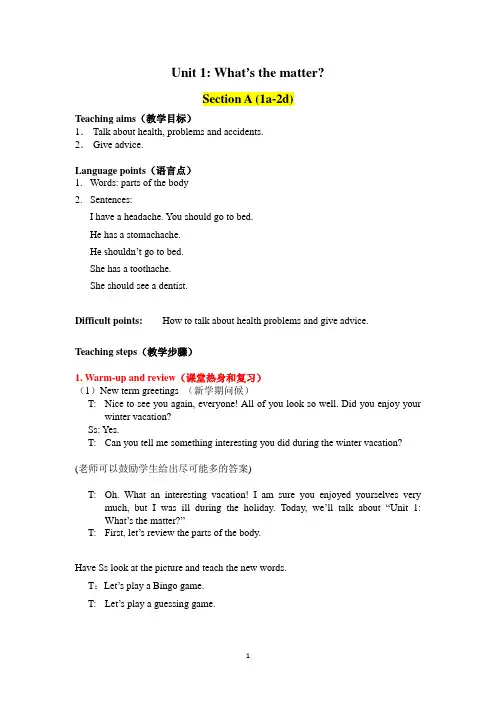
Unit 1: What’s the matter?Section A (1a-2d)Teaching aims(教学目标)1.Talk about health, problems and accidents.2.Give advice.Language points(语言点)1.Words: parts of the body2.Sentences:I have a headache. You should go to bed.He has a stomachache.He shouldn’t go to bed.She has a toothache.She should see a dentist.Difficult points: How to talk about health problems and give advice.Teaching steps(教学步骤)1. Warm-up and review(课堂热身和复习)(1)New term greetings (新学期问候)T: Nice to see you again, everyone! All of you look so well. Did you enjoy your winter vacation?Ss: Yes.T: Can you tell me something interesting you did during the winter vacation? (老师可以鼓励学生给出尽可能多的答案)T: Oh. What an interesting vacation! I am sure you enjoyed yourselves very much, but I was ill during the holiday. Today, we’ll talk about “Unit 1: What’s the matter?”T: First, let’s review the parts of the body.Have Ss look at the picture and teach the new words.T:Let’s play a Bingo game.T: Let’s play a guessing game.教学设计说明:复习身体部位并通过游戏巩固,为完成1a服务。
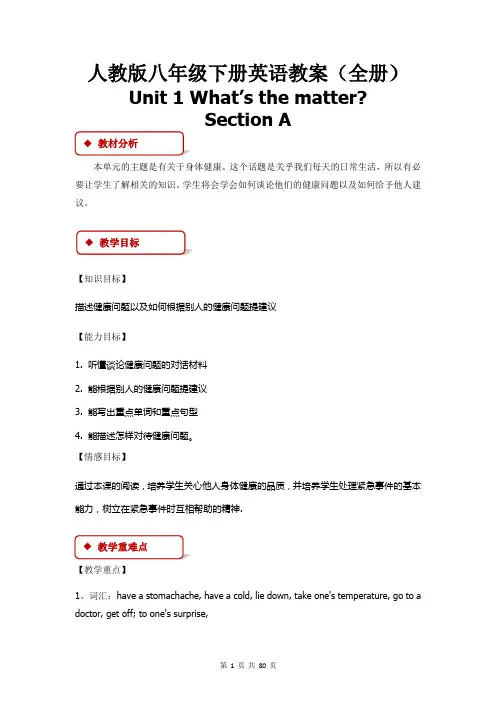
人教版八年级下册英语教案(全册)Unit 1 What’s the matter?Section A◆教材分析本单元的主题是有关于身体健康。
这个话题是关乎我们每天的日常生活,所以有必要让学生了解相关的知识。
学生将会学会如何谈论他们的健康问题以及如何给予他人建议。
◆教学目标【知识目标】描述健康问题以及如何根据别人的健康问题提建议【能力目标】1.听懂谈论健康问题的对话材料2.能根据别人的健康问题提建议3.能写出重点单词和重点句型4.能描述怎样对待健康问题。
【情感目标】通过本课的阅读,培养学生关心他人身体健康的品质,并培养学生处理紧急事件的基本能力,树立在紧急事件时互相帮助的精神.◆教学重难点◆【教学重点】1、词汇:have a stomachache, have a cold, lie down, take one's temperature, go to a doctor, get off; to one's surprise,2、句型:1. ——What's the matter?——I have a stomachache. You shouldn't eat so much next time.2 . ——What's the matter with Ben?——He hurt himself. He has a sore back.——He should lie down and rest.【教学难点】掌握情态动词should shouldn't.的用法;学习have的用法◆课前准备◆Multimedia, group work, cooperative discussion.◆教学过程Step1. Warm up1. Look at the picture and learn the parts of the body.2. New words and phrases.Step 2 Presentation1. 1aLook at the picture. Write the correct letter [a-m] for each part of the body. Then check the answers.2. 1bFirst, lead Ss to read the five names.Then look at the picture. Number the names 1-5.Finally, check the answers.3. 1cDivide two Ss into a pair to make conversations. Finally, invite several pairs to act out for the class.Step 3 Practice1. 2aTell Ss there are five conversations. In each conversation the person says what’s going on with them. Listen carefully and number the pictures.Play the tape. Then check the answers.2. 2bAsk Ss to listen to the recording again to match the problems with the advice.Play the recording again. Then check the answers.3. 2cAsk Ss to make conversations using the information in 2a and2b. Give them enough time to do this task. Later, invite several pairs to present their conversations to the class.Step 4 Consolidation1. 2dFirst, ask Ss to have a fast reading of the conversation to get the main idea.Then, lead Ss to read the conversation sentence by sentence, explain some language points.Finally, divide Ss into pairs to practice role-playing the conversation.2. 3aFirst, read the passage quickly and answer the question.Then, lead Ss to read the passage and analyse the key points.Finally, read together.3. 3bRead the passage again and check the things that happened in the story3cDiscuss the questions with a partner.4. Grammar focusFirst, lead Ss to read the sentences.Then, prompt Ss to analyse the use of model verb should.After that, explain the grammar together.5. 4aAsk Ss to fill in the blanks.Then , invite some Ss to present their answers.6. 4bAsk Ss to circle the best advice for these health problems, then add their own advice.After that, invite some Ss to present their advice.7. 4cOne student mimes a problem. The other students in your group guess the problem and give advice.Step 5 Language pointsStep 6 HomeworkMake a conversation about health problems and giving advice.Unit 1 What’s the matter?Section B◆教材分析本单元的主题是有关于身体健康。
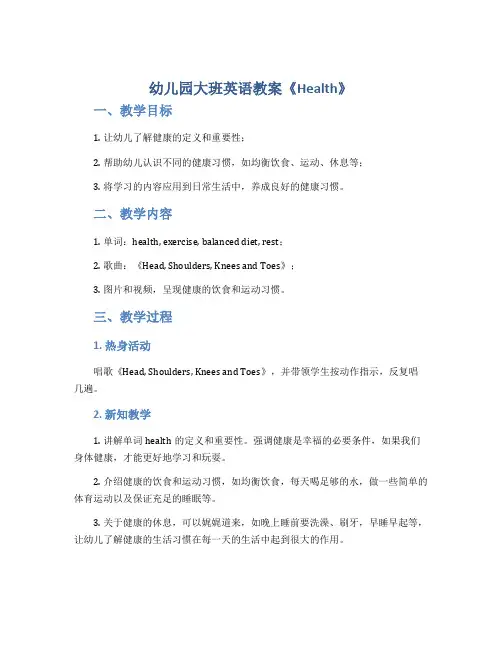
幼儿园大班英语教案《Health》一、教学目标1.让幼儿了解健康的定义和重要性;2.帮助幼儿认识不同的健康习惯,如均衡饮食、运动、休息等;3.将学习的内容应用到日常生活中,养成良好的健康习惯。
二、教学内容1.单词:health, exercise, balanced diet, rest;2.歌曲:《Head, Shoulders, Knees and Toes》;3.图片和视频,呈现健康的饮食和运动习惯。
三、教学过程1. 热身活动唱歌《Head, Shoulders, Knees and Toes》,并带领学生按动作指示,反复唱几遍。
2. 新知教学1.讲解单词health的定义和重要性。
强调健康是幸福的必要条件,如果我们身体健康,才能更好地学习和玩耍。
2.介绍健康的饮食和运动习惯,如均衡饮食,每天喝足够的水,做一些简单的体育运动以及保证充足的睡眠等。
3.关于健康的休息,可以娓娓道来,如晚上睡前要洗澡、刷牙,早睡早起等,让幼儿了解健康的生活习惯在每一天的生活中起到很大的作用。
3. 练习和巩固1.分组进行游戏。
将健康的饮食和运动习惯进行分类,让学生用图片和单词对应起来,不仅加深了学生对单词的记忆,还能够通过游戏形式巩固所学内容。
2.幼儿园大班的孩子们喜欢动手,可以通过让每个学生制作健康饮食或健康运动的卡片,从而让每个孩子参与到当中。
健康的卡片可以以图片为主,也可以上显示单词。
4. 给家长的建议在班级通讯中,向家长推荐本节课中所学到的内容,并鼓励家长通过在家中跟孩子一起制作健康食品或者安排一些每日的户外活动来转化本次课程中学到的内容。
四、教学评价通过观察学生的学习态度和参与度,老师可以对学生是否掌握本次课程所讲解的内容有一个清晰的认识。
同时,对于知识点的思维拓展还需通过学生自己的实际行动来验证。
建议教师会在实际学生的生活中经常提起健康与生活习惯知识点的应用,并关注学生是否能够应用到实际生活中。
中等专业学校教案教学设计中等专业学校教案教学设计中等专业学校教案教学设计中等专业学校教案教学设计中等专业学校教案教学设计中等专业学校教案教学设计中等专业学校教案教学设计中等专业学校教案教学设计中等专业学校教案教学设计2.Can you talk about functions of an iPad?6.Can you cooperate with your partner well?7.Can you catch the key information in Listening B? 1.Surf the Internet to find more information about iPad.中等专业学校教案教学设计____opy c____atPh___to___raphb. “Chant & sing”Teach the students to “Chant & Sing simple words.Such as:d. crosswords:Divide the whole class into 4 groupsone picture of crosswords, and write down all the words in the crosswords. Students can havegsd vanize the students to read the words and expressions together.2.Try to design a short passage that中等专业学校教案教学设计1.Ask Ss to go through the passage , and tell out the general idea of the passage. Lead the students to answer this question:“Is the web of lies?”wonderful. .1.Surf the Internet to find some interesting micoblogs.中等专业学校教案。
八年级下册英语教案全英文版Unit 1 What's the matter?一、Teaching aims。
1. Students will be able to master the key vocabulary related to health problems and advice, such as "have a cold", "have a stomachache", "lie down", "take one's temperature", etc.2. Students will be able to use the target language "What's the matter?I have a... You should/shouldn't..." to talk about health problems and give advice.3. Students will be able to improve their listening and speaking skills through various activities.4. Students will develop the awareness of taking care of themselves and others' health.二、Teaching key points。
1. Master the key vocabulary and target language.2. Be able to use the target language to have a conversation about health problems and advice.三、Teaching difficult points。
(共 4 册)
清华大学教案
(第二册)
课程名称大学英语(二)
教学单位大学英语教研室
主讲教师职称
课程性质公共基础必修总学时 240 总学分 14 授课班级总人数
课程授课学期 4 学期起止时间2016 年 09 月至 2018 年 07 月
本册教案用于第2学期起止时间 2017 年 02 月至 2017 年 07 月
所用教材及编者《全新版大学英语综合教程2》(李荫华总主编)
(上海外语教育出版社2014年6月第2版)
《新视野大学英语视听说教程2》(郑树棠编著)
((外语教学与研究出版社2015年6月第三版)
主要参考书及编者 1. 《全新版大学英语综合教程2》教师手册(李荫华总主编)
(上海外语教育出版社2014年6月第2版)
2. 《新视野大学英语视听说教程2》教师用书(郑树棠编著)
(外语教学与研究出版社2015年6月第三版)
常州大学教务处制
本册教案目录
16-17-2大学英语(二)怀德学院教案第一次课__8__学时授课时间第1-2 周教案完成时间2017. 2
16-17-2大学英语(二)怀德学院教案第二次课8 学时授课时间第3-4 周教案完成时间2017.2
16-17-2大学英语(二)怀德学院教案
16-17-2大学英语(二)怀德学院教案
16-17-2大学英语(二)怀德学院教案
16-17-2大学英语(二)怀德学院教案
16-17-2大学英语(二)怀德学院教案
教学总结。
大班英语活动教案《Health》第一章:活动目标1.1 知识目标:1. 能听懂、会说、会读关于健康饮食的英语单词和句型,如:apple, banana, orange, healthy, unhealthy, I like, Do you like?1.2 技能目标:2. 能够用英语简单描述自己喜欢的食物,并能够询问他人喜欢的食物。
1.3 情感目标:3. 培养幼儿对健康饮食的兴趣,增强健康饮食的意识。
第二章:活动重难点2.1 活动重点:4. 学习关于健康饮食的英语单词和句型。
2.2 活动难点:5. 能够用英语询问他人喜欢的食物,并能够用英语描述自己喜欢的食物。
第三章:活动准备6. 教具准备:7. 水果卡片(apple, banana, orange)、食物图片、健康和不健康的食物图片。
6. 环境准备:8. 安静、舒适的活动室,有利于幼儿集中注意力。
9. 引入:10. 教师向幼儿展示水果卡片,引导幼儿说出水果的名字,并询问幼儿是否喜欢这些水果。
11. 教师通过提问,引导幼儿思考健康饮食的重要性。
10. 主体活动:12. 教师出示食物图片,引导幼儿用英语描述自己喜欢的食物。
13. 教师出示健康和不健康的食物图片,引导幼儿用英语区分,并说出自己的看法。
11. 总结结束:14. 教师引导幼儿总结今天学习的单词和句型,并鼓励幼儿在日常生活中多使用英语。
第五章:活动延伸16. 家园共育:18. 环境创设:19. 教师在活动室布置健康饮食的主题墙,引导幼儿观察和讨论。
20. 区域活动:21. 教师在角色区设置健康饮食的小店,引导幼儿进行角色扮演,运用英语交流。
22. 教学评价:23. 教师通过观察幼儿在活动中的参与程度、语言表达能力和对健康饮食的认识,对本次活动进行评价。
24. 直观法:25. 通过展示水果卡片和食物图片,让幼儿直观地学习英语单词和句型。
26. 情境教学法:27. 创设真实的购物情境,让幼儿在实践中学习英语,提高语言运用能力。
大班英语活动教案《Health》第一章:活动目标1.1 知识目标:让幼儿了解和掌握与健康相关的词汇,如:healthy, sick, doctor, medicine等。
1.2 技能目标:让幼儿能够在日常生活中正确使用英语表达与健康相关的事物和概念。
1.3 情感目标:第二章:活动准备2.1 教具准备:健康相关词汇卡片、健康食物图片、医生服装、药品模型等。
2.2 环境准备:安静、舒适的活动室,有助于幼儿集中注意力。
第三章:活动过程3.1 热身活动(5分钟)教师带领幼儿唱一首英文歌曲《Healthy Food》,激发幼儿对健康的兴趣。
3.2 教学活动(10分钟)教师向幼儿展示健康相关词汇卡片,如:healthy, sick, doctor, medicine等,引导幼儿用中文说出这些词汇的意思,用英语重复。
3.3 实践环节(5分钟)教师扮演医生,让幼儿扮演病人,进行看病的角色扮演。
在扮演过程中,教师引导幼儿使用英语表达病情和治疗方法。
3.4 总结环节(5分钟)教师带领幼儿回顾本节课所学内容,让幼儿用英语说出健康的重要性。
第四章:活动延伸4.1 家庭作业:让幼儿和家长一起完成一份关于健康的食物和生活习惯的调查表。
4.2 环境创设:在活动室布置一个健康角,展示健康食物和健康生活方式的图片。
第五章:教学评价5.1 幼儿评价:观察幼儿在课堂上的参与程度、英语表达能力和对健康知识的理解程度。
5.2 家长评价:通过与家长的沟通,了解幼儿在家庭中对健康知识的学习和应用情况。
5.3 自我评价:教师根据教学过程中的实际情况,反思教学方法的有效性,不断调整和改进。
第六章:教学内容6.1 课程主题:健康饮食6.2 学习目标:能识别和说出各种健康食物的名字,如fruits, vegetables, milk, water 等。
能够理解和表达食物对健康的影响,如"eat more fruits and vegetables" "drink more water"。
A lesson Plan
School: lixi Middle School
Subject: Oxford English 6B U4 Staying healthy
Teacher: tangchunhong
Students: Class_10____, Grade 6.BaiCai Middle School
Date: March 20, 2013
Content U4 listening and speaking Health problem
Teaching objectives Knowledge
objectives
By the end of the lesson, the students are
expected :
1 be able to learn some new words.
2 be able to use the simple present tense
to ask wh-questions
3 be able to use connectives to give reasons
It’s because….
4 be able to use adverbs of degree too
much/many
Ability
objectives
To develop the skills of listening and
speaking by practicing
Emotion
objectives
To make students know: health is very
important
to us. We should do exercise every day
and have a good life habit.
Teaching aids
multi-media
Student’s Book 6B page 24-25 Workbook 6B page 22,27
Difficult point To use connectives to give reasons It’s because…
To give advice: you should…
Teaching Procedures
Step Teacher’s
activities Students’
activities
Purpose
Pre-task
preparation
play a song Listen and sing 1. To warm the atmosphere
1 To show some pictures and new words.
2ask some students to act out . 1To learn new words
with the help of the
pictures
2 look and answer
1. To help the students learn
news words
2. to consolidate the new
words
While-task procedures 3 ask the
students to
listen and fill
the blanks
4 ask the
students to
practice in pair
5 play a report
from Dr chen
3 Listen、 fill and
speak
4 Pair work
5listen and write
3.to develop the skills of
listening and speaking
4. To improve the students’
ability of co-operation
5 to listen and fill the
blanks
Post-task activities 1. ask the
students to find
more reasons of
causing health
problems
2 let the
students work in
a group
1. brainstorm
2 work in a group of
four
1. to extend students’
thoughts
2 to develop the speaking
ability.
Assignment
1Read page 24,25fluently.
2 Finish workbook page 22,27
Thanks !。